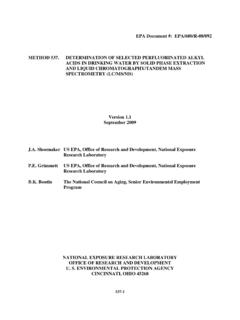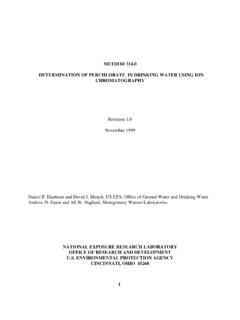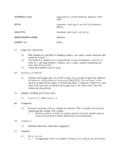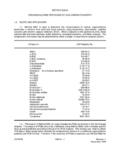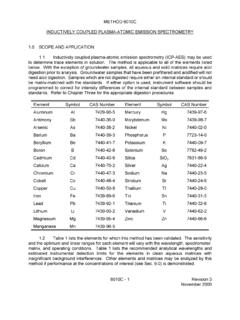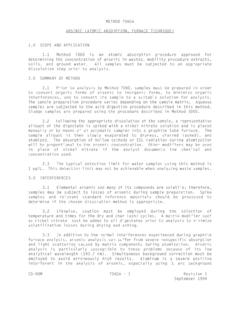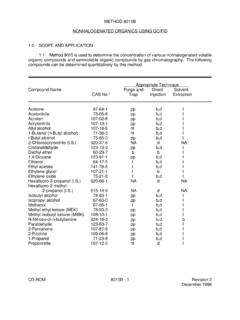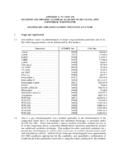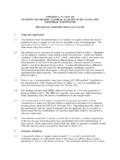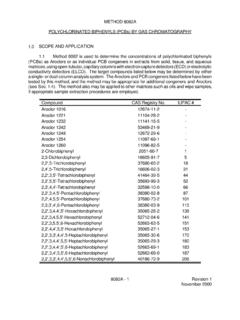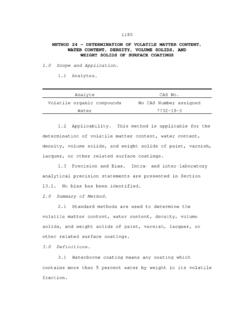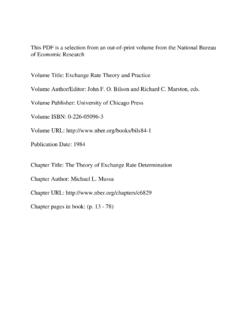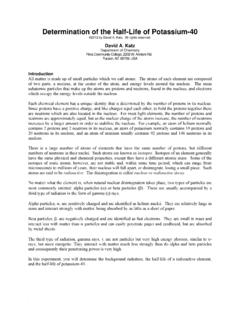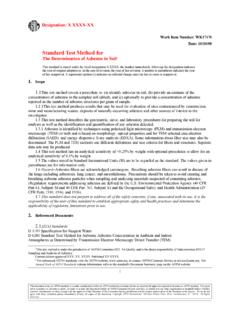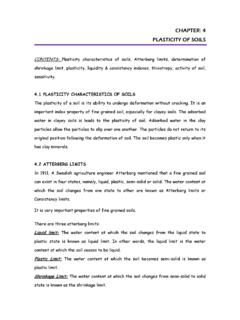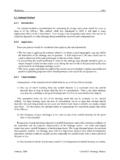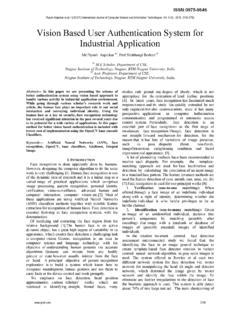Transcription of METHOD 19 - DETERMINATION OF SULFUR …
1 1122. METHOD 19 - DETERMINATION OF SULFUR DIOXIDE REMOVAL. EFFICIENCY AND PARTICULATE MATTER, SULFUR DIOXIDE, AND NITROGEN OXIDE EMISSION RATES. Scope and Application Analytes. This METHOD provides data reduction procedures relating to the following pollutants, but does not include any sample collection or analysis procedures. Analyte CAS No. Sensitivity Nitrogen oxides (NOx), N/A. including: 10102-43-9. Nitric oxide (NO) 10102-44-0. Nitrogen dioxide (NO2). Particulate matter (PM) None assigned N/A. SULFUR dioxide (SO2) 7499-09-05 N/A. Applicability. Where specified by an applicable subpart of the regulations, this METHOD is applicable for the DETERMINATION of (a) PM, SO2, and NOx emission rates; (b).
2 SULFUR removal efficiencies of fuel pretreatment and SO2 control devices; and (c) overall reduction of potential SO2 emissions. Summary of METHOD . Emission Rates. Oxygen (O2) or carbon dioxide (CO2) concentrations and appropriate F factors (ratios of combustion gas volumes to heat inputs) are used to calculate pollutant emission rates from pollutant concentrations. SULFUR Reduction Efficiency and SO2 Removal Efficiency. An overall SO2 emission reduction efficiency is computed from the efficiency of fuel pretreatment systems, where applicable, and the efficiency of SO2 control devices. 1123. The SULFUR removal efficiency of a fuel pretreatment system is determined by fuel sampling and analysis of the SULFUR and heat contents of the fuel before and after the pretreatment system.
3 The SO2 removal efficiency of a control device is determined by measuring the SO2 rates before and after the control device. The inlet rates to SO2 control systems (or, when SO2 control systems are not used, SO2 emission rates to the atmosphere) are determined by fuel sampling and analysis. Definitions. [Reserved]. Interferences. [Reserved]. Safety. [Reserved]. Equipment and Supplies. [Reserved]. Reagents and Standards. [Reserved]. Sample Collection, Preservation, Storage, and Transport. [Reserved]. Quality Control. [Reserved]. Calibration and Standardization. [Reserved]. Analytical Procedures. [Reserved]. Data Analysis and Calculations. Nomenclature. Bwa = Moisture fraction of ambient air, percent.
4 Bws = Moisture fraction of effluent gas, percent. 1124. %C = Concentration of carbon from an ultimate analysis of fuel, weight percent. Cd = Pollutant concentration, dry basis, ng/scm (lb/scf). %CO2d,%CO2w = Concentration of carbon dioxide on a dry and wet basis, respectively, percent. Cw = Pollutant concentration, wet basis, ng/scm (lb/scf). D = Number of sampling periods during the performance test period. E = Pollutant emission rate, ng/J (lb/million Btu). Ea = Average pollutant rate for the specified performance test period, ng/J (lb/million Btu). Eao, Eai = Average pollutant rate of the control device,outlet and inlet, respectively, for the performance test period, ng/J (lb/million Btu).
5 Ebi = Pollutant rate from the steam generating unit, ng/J (lb/million Btu). Ebo = Pollutant emission rate from the steam generating unit, ng/J. (lb/million Btu). Eci = Pollutant rate in combined effluent, ng/J (lb/million Btu). Eco = Pollutant emission rate in combined effluent, ng/J (lb/million Btu). 1125. Ed = Average pollutant rate for each sampling period ( , 24-hr METHOD 6B sample or 24-hr fuel sample) or for each fuel lot ( , amount of fuel bunkered), ng/J (lb/million Btu). Edi = Average inlet SO2 rate for each sampling period d, ng/J. (lb/million Btu). Eg = Pollutant rate from gas turbine, ng/J (lb/million Btu). Ega = Daily geometric average pollutant rate, ng/J (lbs/million Btu).
6 Or ppm corrected to 7 percent O2. Ejo,Eji = Matched pair hourly arithmetic average pollutant rate, outlet and inlet, respectively, ng/J (lb/million Btu) or ppm corrected to 7 percent O2. Eh = Hourly average pollutant, ng/J (lb/million Btu). Ehj = Hourly arithmetic average pollutant rate for hour "j," ng/J. (lb/million Btu) or ppm corrected to 7 percent O2. EXP = Natural logarithmic base ( ) raised to the value enclosed by brackets. Fd, Fw, Fc = Volumes of combustion components per unit of heat content, scm/J (scf/million Btu). GCV = Gross calorific value of the fuel consistent with the ultimate analysis, kJ/kg (Btu/lb). GCVp, GCVr = Gross calorific value for the product and raw fuel lots, respectively, dry basis, kJ/kg (Btu/lb).
7 1126. %H = Concentration of hydrogen from an ultimate analysis of fuel, weight percent. H = Total number of operating hours for which pollutant rates are determined in the performance test period. Hb = Heat input rate to the steam generating unit from fuels fired in the steam generating unit, J/hr (million Btu/hr). Hg = Heat input rate to gas turbine from all fuels fired in the gas turbine, J/hr (million Btu/hr). %H2O = Concentration of water from an ultimate analysis of fuel, weight percent. Hr = Total numbers of hours in the performance test period ( , 720 hours for 30-day performance test period). K = Conversion factor, 10-5 (kJ/J)/(%) [106 Btu/million Btu]. Kc = ( scm/kg)/% [( scf/lb)/%].
8 Kcc = ( scm/kg)/% [( scf/lb)/%]. Khd = ( scm/kg)/% [( scf/lb)/%]. Khw = ( scm/kg)/% [( scf/lb)/%]. Kn = ( scm/kg)/% [( scf/lb)/%]. Ko = ( scm/kg)/% [( scf/lb)/%]. Ks = ( scm/kg)/% [( scf/lb)/%]. Kw = ( scm/kg)/% [( scf/lb)/%]. ln = Natural log of indicated value. 1127. Lp,Lr = Weight of the product and raw fuel lots, respectively, metric ton (ton). %N = Concentration of nitrogen from an ultimate analysis of fuel, weight percent. N = Number of fuel lots during the averaging period. n = Number of fuels being burned in combination. nd = Number of operating hours of the affected facility within the performance test period for each Ed determined. nt = Total number of hourly averages for which paired inlet and outlet pollutant rates are available within the 24-hr midnight to midnight daily period.
9 %O = Concentration of oxygen from an ultimate analysis of fuel, weight percent. %O2d, %O2w = Concentration of oxygen on a dry and wet basis, respectively, percent. Ps = Potential SO2 emissions, percent. %Rf = SO2 removal efficiency from fuel pretreatment, percent. %Rg = SO2 removal efficiency of the control device, percent. %Rga = Daily geometric average percent reduction. %Ro = Overall SO2 reduction, percent. %S = Concentration of SULFUR from an ultimate analysis of fuel, weight percent. 1128. %Sf = SULFUR content of as-fired fuel lot, dry basis, weight percent. Se = Standard deviation of the hourly average pollutant rates for each performance test period, ng/J (lb/million Btu).
10 Si = Standard deviation of the hourly average inlet pollutant rates for each performance test period, ng/J (lb/million Btu). So = Standard deviation of the hourly average emission rates for each performance test period, ng/J (lb/million Btu). %Sp, %Sr = SULFUR content of the product and raw fuel lots respectively, dry basis, weight percent. = Values shown in Table 19-3 for the indicated number of data points n. Xk = Fraction of total heat input from each type of fuel k. Emission Rates of PM, SO2, and NOx. Select from the following sections the applicable procedure to compute the PM, SO2, or NOx emission rate (E) in ng/J. (lb/million Btu). The pollutant concentration must be in ng/scm (lb/scf) and the F factor must be in scm/J (scf/million Btu).
